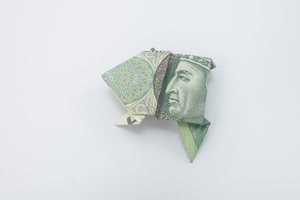100 Złoty Frog

Polish banknotes have 2:1 proportions, a square folded in half. This makes them good for adapting models folded from square paper. I came up with the idea of folding a traditional jumping frog from a 100 złoty bill when I was folding with a bunch of friends, and we ordered pizza. Despite being a little surprised, the delivery man accepted the payment. The 100 zł bill also happens to be green which fits the subject, and if you orient the folding correctly, you can fit the imagery on the bill nicely into the model, with the round rosette on the snout and the portrait of king Władysław Jagiełło on the body.
Dollar bills are quite popular as folding material and there is whole genre dedicated to dollar bill origami, so if time allows, I’d like to explore folding Polish currency as well. Different bills have different colors, so there’s more variety than among dollar bills. On the other hand, if you want to pick colors and plan to keep the models, you have to freeze a larger sum: the smallest value bill is zł 10 (brown) which is worth a bit above $2, the highest in common use is zł 200 (yellow) worth about $45.
Comments